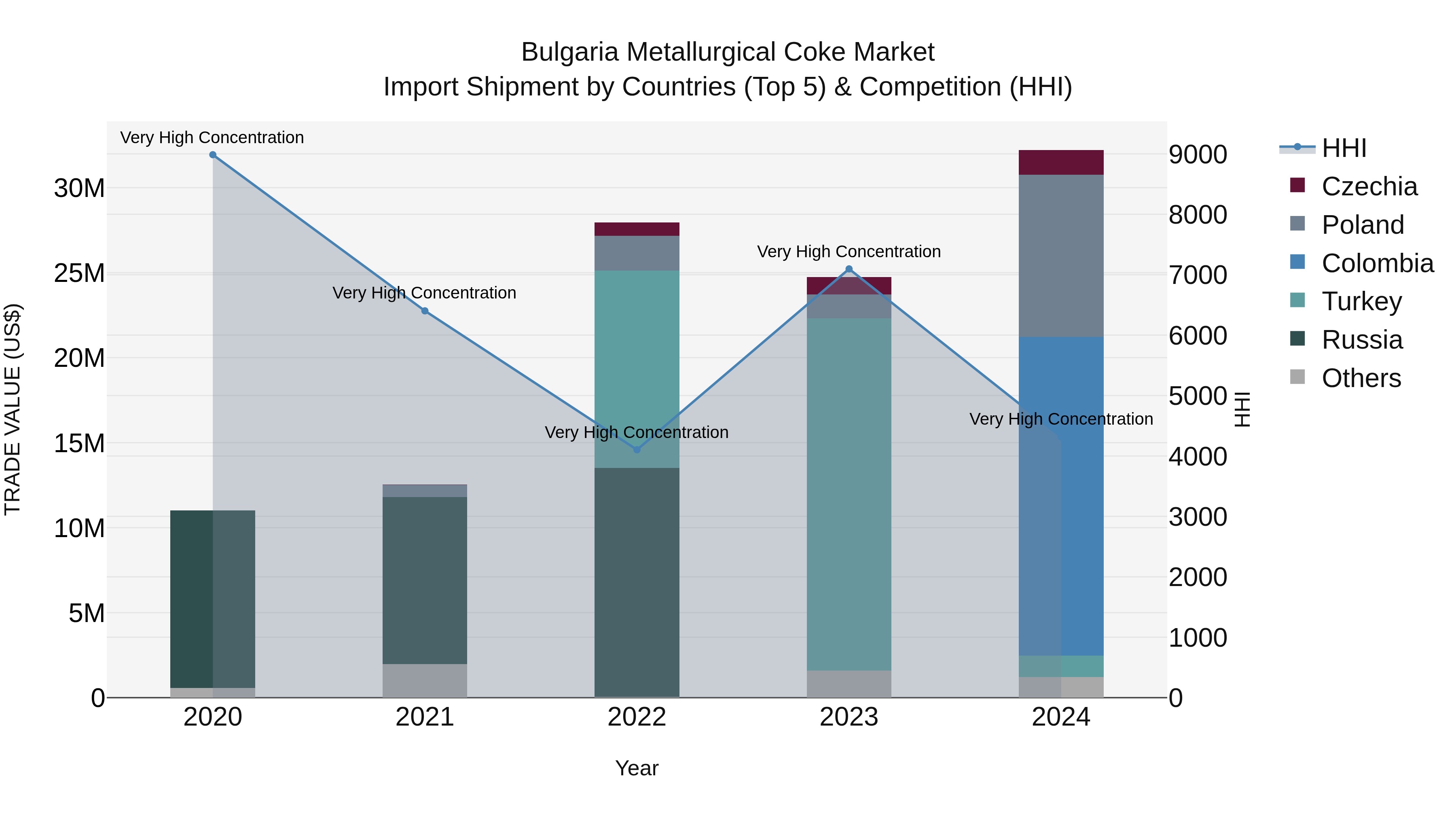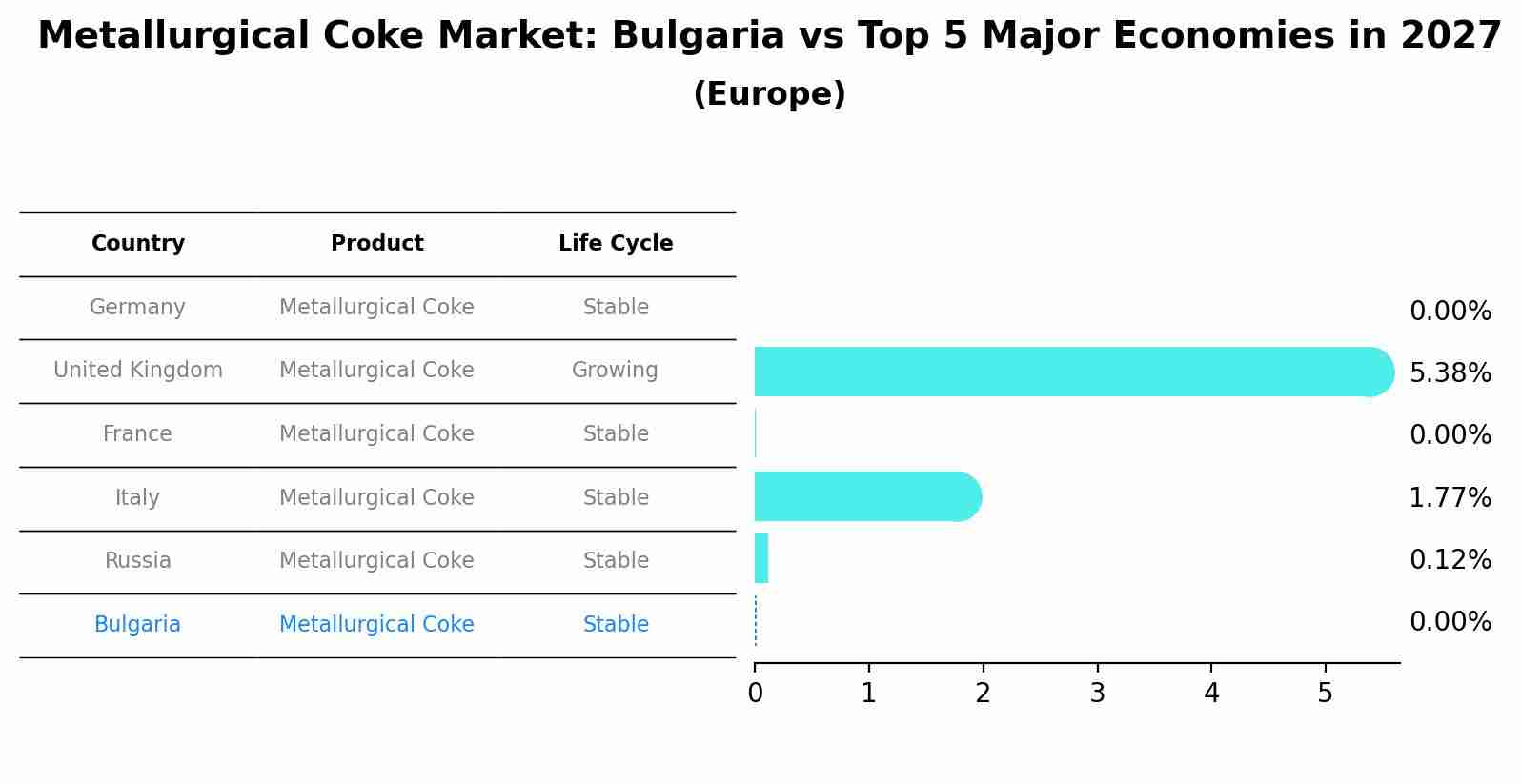Bulgaria Metallurgical Coke Market (2025-2031) | Share, Value, Segmentation, Forecast, Outlook, Industry, Size, Revenue, Trends, Companies, Growth & Analysis
| Product Code: ETC4675493 | Publication Date: Nov 2023 | Updated Date: Oct 2025 | Product Type: Market Research Report | |
| Publisher: 6Wresearch | Author: Shubham Deep | No. of Pages: 60 | No. of Figures: 30 | No. of Tables: 5 |
Bulgaria Metallurgical Coke Market Top 5 Importing Countries and Market Competition (HHI) Analysis
Bulgaria`s metallurgical coke import Market Top 5 Importing Countries and Market Competition (HHI) Analysis continued to thrive in 2024, with significant shipments coming from Colombia, Poland, Czechia, Turkey, and Kazakhstan. The high Herfindahl-Hirschman Index (HHI) reflects a concentrated Market Top 5 Importing Countries and Market Competition (HHI) Analysis structure. The impressive compound annual growth rate (CAGR) of 30.78% from 2020 to 2024 indicates a robust expansion trend. Moreover, the growth rate of 30.14% in 2024 highlights the resilience and attractiveness of Bulgaria`s metallurgical coke import sector, positioning it as a key player in the global Market Top 5 Importing Countries and Market Competition (HHI) Analysis .

Metallurgical Coke Market: Bulgaria vs Top 5 Major Economies in 2027 (Europe)
By 2027, the Metallurgical Coke market in Bulgaria is anticipated to reach a growth rate of 0.00%, as part of an increasingly competitive Europe region, where Germany remains at the forefront, supported by United Kingdom, France, Italy and Russia, driving innovations and market adoption across sectors.

Bulgaria Metallurgical Coke Market Overview
The Metallurgical Coke market in Bulgaria is vital for the steel industry, where coke is used as a reducing agent in the production of iron. The market is driven by the demand for steel in construction, automotive, and manufacturing.
Drivers of the market
The Bulgaria metallurgical coke market is driven by its essential role in the production of steel and other metals. Metallurgical coke, a high-carbon product derived from coal, is used as a reducing agent in blast furnaces, where it facilitates the extraction of metals from their ores. The market is influenced by the demand for steel in construction, automotive, and industrial applications, as well as the availability and price of coal. Environmental regulations and the development of alternative methods for steel production may impact the market, but metallurgical coke remains a critical component in traditional metallurgical processes.
Challenges of the market
The metallurgical coke market in Bulgaria faces challenges related to environmental regulations and competition from alternative materials. Stringent environmental policies aimed at reducing carbon emissions require coke producers to implement costly technologies and processes to minimize their environmental impact. Additionally, competition from alternative materials, such as direct reduced iron (DRI) and electric arc furnace (EAF) steelmaking, can affect demand for metallurgical coke. Market volatility in raw material prices and supply chain disruptions also pose risks to stability and profitability.
Government Policy of the market
The metallurgical coke market in Bulgaria is influenced by policies that regulate the production and use of coke in industrial processes. The government enforces standards to ensure the safety and environmental impact of metallurgical coke, which is used in steelmaking and other applications. Policies may include incentives for companies that adopt cleaner and more efficient coke production technologies.
Key Highlights of the Report:
- Bulgaria Metallurgical Coke Market Outlook
- Market Size of Bulgaria Metallurgical Coke Market, 2024
- Forecast of Bulgaria Metallurgical Coke Market, 2031
- Historical Data and Forecast of Bulgaria Metallurgical Coke Revenues & Volume for the Period 2021-2031
- Bulgaria Metallurgical Coke Market Trend Evolution
- Bulgaria Metallurgical Coke Market Drivers and Challenges
- Bulgaria Metallurgical Coke Price Trends
- Bulgaria Metallurgical Coke Porter`s Five Forces
- Bulgaria Metallurgical Coke Industry Life Cycle
- Historical Data and Forecast of Bulgaria Metallurgical Coke Market Revenues & Volume By Grade for the Period 2021-2031
- Historical Data and Forecast of Bulgaria Metallurgical Coke Market Revenues & Volume By Low Ash for the Period 2021-2031
- Historical Data and Forecast of Bulgaria Metallurgical Coke Market Revenues & Volume By High Ash for the Period 2021-2031
- Historical Data and Forecast of Bulgaria Metallurgical Coke Market Revenues & Volume By Applications for the Period 2021-2031
- Historical Data and Forecast of Bulgaria Metallurgical Coke Market Revenues & Volume By ron and Steel Making for the Period 2021-2031
- Historical Data and Forecast of Bulgaria Metallurgical Coke Market Revenues & Volume By Sugar Processing for the Period 2021-2031
- Historical Data and Forecast of Bulgaria Metallurgical Coke Market Revenues & Volume By Glass Manufacturing for the Period 2021-2031
- Historical Data and Forecast of Bulgaria Metallurgical Coke Market Revenues & Volume By Others Applications for the Period 2021-2031
- Bulgaria Metallurgical Coke Import Export Trade Statistics
- Market Opportunity Assessment By Grade
- Market Opportunity Assessment By Applications
- Bulgaria Metallurgical Coke Top Companies Market Share
- Bulgaria Metallurgical Coke Competitive Benchmarking By Technical and Operational Parameters
- Bulgaria Metallurgical Coke Company Profiles
- Bulgaria Metallurgical Coke Key Strategic Recommendations
Frequently Asked Questions About the Market Study (FAQs):
1 Executive Summary |
2 Introduction |
2.1 Key Highlights of the Report |
2.2 Report Description |
2.3 Market Scope & Segmentation |
2.4 Research Methodology |
2.5 Assumptions |
3 Bulgaria Metallurgical Coke Market Overview |
3.1 Bulgaria Country Macro Economic Indicators |
3.2 Bulgaria Metallurgical Coke Market Revenues & Volume, 2021 & 2031F |
3.3 Bulgaria Metallurgical Coke Market - Industry Life Cycle |
3.4 Bulgaria Metallurgical Coke Market - Porter's Five Forces |
3.5 Bulgaria Metallurgical Coke Market Revenues & Volume Share, By Grade, 2021 & 2031F |
3.6 Bulgaria Metallurgical Coke Market Revenues & Volume Share, By Applications, 2021 & 2031F |
4 Bulgaria Metallurgical Coke Market Dynamics |
4.1 Impact Analysis |
4.2 Market Drivers |
4.3 Market Restraints |
5 Bulgaria Metallurgical Coke Market Trends |
6 Bulgaria Metallurgical Coke Market Segmentations |
6.1 Bulgaria Metallurgical Coke Market, By Grade |
6.1.1 Overview and Analysis |
6.1.2 Bulgaria Metallurgical Coke Market Revenues & Volume, By Low Ash, 2021-2031F |
6.1.3 Bulgaria Metallurgical Coke Market Revenues & Volume, By High Ash, 2021-2031F |
6.2 Bulgaria Metallurgical Coke Market, By Applications |
6.2.1 Overview and Analysis |
6.2.2 Bulgaria Metallurgical Coke Market Revenues & Volume, By ron and Steel Making, 2021-2031F |
6.2.3 Bulgaria Metallurgical Coke Market Revenues & Volume, By Sugar Processing, 2021-2031F |
6.2.4 Bulgaria Metallurgical Coke Market Revenues & Volume, By Glass Manufacturing, 2021-2031F |
6.2.5 Bulgaria Metallurgical Coke Market Revenues & Volume, By Others Applications, 2021-2031F |
7 Bulgaria Metallurgical Coke Market Import-Export Trade Statistics |
7.1 Bulgaria Metallurgical Coke Market Export to Major Countries |
7.2 Bulgaria Metallurgical Coke Market Imports from Major Countries |
8 Bulgaria Metallurgical Coke Market Key Performance Indicators |
9 Bulgaria Metallurgical Coke Market - Opportunity Assessment |
9.1 Bulgaria Metallurgical Coke Market Opportunity Assessment, By Grade, 2021 & 2031F |
9.2 Bulgaria Metallurgical Coke Market Opportunity Assessment, By Applications, 2021 & 2031F |
10 Bulgaria Metallurgical Coke Market - Competitive Landscape |
10.1 Bulgaria Metallurgical Coke Market Revenue Share, By Companies, 2024 |
10.2 Bulgaria Metallurgical Coke Market Competitive Benchmarking, By Operating and Technical Parameters |
11 Company Profiles |
12 Recommendations | 13 Disclaimer |
- Single User License$ 1,995
- Department License$ 2,400
- Site License$ 3,120
- Global License$ 3,795
Search
Thought Leadership and Analyst Meet
Our Clients
Related Reports
- Canada Oil and Gas Market (2026-2032) | Share, Segmentation, Value, Industry, Trends, Forecast, Analysis, Size & Revenue, Growth, Competitive Landscape, Outlook, Companies
- Germany Breakfast Food Market (2026-2032) | Industry, Share, Growth, Size, Companies, Value, Analysis, Revenue, Trends, Forecast & Outlook
- Australia Briquette Market (2025-2031) | Growth, Size, Revenue, Forecast, Analysis, Trends, Value, Share, Industry & Companies
- Vietnam System Integrator Market (2025-2031) | Size, Companies, Analysis, Industry, Value, Forecast, Growth, Trends, Revenue & Share
- ASEAN and Thailand Brain Health Supplements Market (2025-2031) | Strategy, Consumer Insights, Analysis, Investment Trends, Opportunities, Growth, Size, Share, Industry, Revenue, Segments, Value, Segmentation, Supply, Forecast, Restraints, Outlook, Competition, Drivers, Trends, Demand, Pricing Analysis, Competitive, Strategic Insights, Companies, Challenges
- ASEAN Bearings Market (2025-2031) | Strategy, Consumer Insights, Analysis, Investment Trends, Opportunities, Growth, Size, Share, Industry, Revenue, Segments, Value, Segmentation, Supply, Forecast, Restraints, Outlook, Competition, Drivers, Trends, Demand, Pricing Analysis, Competitive, Strategic Insights, Companies, Challenges
- Europe Flooring Market (2025-2031) | Outlook, Share, Industry, Trends, Forecast, Companies, Revenue, Size, Analysis, Growth & Value
- Saudi Arabia Manlift Market (2025-2031) | Outlook, Size, Growth, Trends, Companies, Industry, Revenue, Value, Share, Forecast & Analysis
- Uganda Excavator, Crane, and Wheel Loaders Market (2025-2031) | Strategy, Consumer Insights, Analysis, Investment Trends, Opportunities, Growth, Size, Share, Industry, Revenue, Segments, Value, Segmentation, Supply, Forecast, Restraints, Outlook, Competition, Drivers, Trends, Demand, Pricing Analysis, Competitive, Strategic Insights, Companies, Challenges
- Rwanda Excavator, Crane, and Wheel Loaders Market (2025-2031) | Strategy, Consumer Insights, Analysis, Investment Trends, Opportunities, Growth, Size, Share, Industry, Revenue, Segments, Value, Segmentation, Supply, Forecast, Restraints, Outlook, Competition, Drivers, Trends, Demand, Pricing Analysis, Competitive, Strategic Insights, Companies, Challenges
Industry Events and Analyst Meet
Whitepaper
- Middle East & Africa Commercial Security Market Click here to view more.
- Middle East & Africa Fire Safety Systems & Equipment Market Click here to view more.
- GCC Drone Market Click here to view more.
- Middle East Lighting Fixture Market Click here to view more.
- GCC Physical & Perimeter Security Market Click here to view more.
6WResearch In News
- Doha a strategic location for EV manufacturing hub: IPA Qatar
- Demand for luxury TVs surging in the GCC, says Samsung
- Empowering Growth: The Thriving Journey of Bangladesh’s Cable Industry
- Demand for luxury TVs surging in the GCC, says Samsung
- Video call with a traditional healer? Once unthinkable, it’s now common in South Africa
- Intelligent Buildings To Smooth GCC’s Path To Net Zero


















